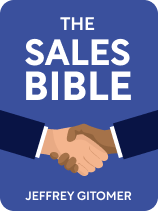

This article is an excerpt from the Shortform book guide to "The Sales Bible" by Jeffrey Gitomer. Shortform has the world's best summaries and analyses of books you should be reading.
Like this article? Sign up for a free trial here .
Can you close sales without being pushy? What is the non-close close?
Closing the sale is the last step in the sales process. In The Sales Bible, Jeffrey Gitomer discusses four strategies to help prospective customers make the decision to buy.
Keep reading to learn how to close the sale.
How to Close the Sale
Listening is an essential part of selling. By understanding what your customer is saying—or not saying—you can determine what to do to convince the customer to buy. Gitomer offers four strategies on how to close the sale:
1) Be Aware of Buying Cues
When customers are interested in what you’re offering but aren’t fully convinced to buy, they send out buying cues, or hints that they’re considering making a purchase. For example, a customer might ask for more information, inquire about promotions, or tell you about their experience with another supplier. Once you’re aware of these signals, Gitomer says that you should immediately move on to the next step. (Shortform note: Gitomer advises focusing solely on verbal cues; however, non-verbal buying cues can be just as important. Some examples of non-verbal cues are customers looking through your sales literature with interest, jotting down notes, or making computations.)
2) Ask for the Sale
Gitomer writes that asking for the sale is such a simple step, but many salespeople neglect to do it. As soon as you recognize that a customer is sending out buying signals, ask a question that addresses their need and that excludes “no” as a possible answer. For example, if they ask about availability, you can respond with “Would you like this delivered by Friday or Monday?”
(Shortform note: Gitomer’s technique is called the assumptive close—you assume a prospect’s commitment to buy even if they haven’t expressly agreed to do so. It’s one of several standard closing tactics that Neil Rackham mentions in SPIN Selling. However, Rackham argues that these closing tactics are typically less effective when your products have higher price points or when your customer is an experienced purchasing agent.)
3) Address Concerns
If a customer hasn’t committed to making a purchase, Gitomer says you should find out the real reason behind their hesitation. Typically, it’s because they have unanswered questions, want a better deal, need someone else’s approval, or have no need for your product. Once you clarify what their objections are, you can address their concerns by using your sales tools (such as literature and testimonials) or to ask a question that includes a solution to their objection. For example, if they object to the price, you can ask, “If I can give you flexible payment terms, would that help you make a decision?”
| Overcome Objections by Creating Certainty Prospects typically have objections because they’re uncertain about something. In Way of the Wolf, sales trainer Jordan Belfort asserts that your objective is to move prospects away from uncertainty by establishing three certainties in their minds: 1) The product: The prospect must love the product or believe that they can benefit from it. 2) The seller (you): The prospect must find you trustworthy and likable. 3) Your company or brand: The prospect must see your company or brand in a positive light. Belfort adds that you must create certainty on two levels: the logical level (the product meets the prospect’s needs, is priced fairly) and the emotional level (the prospect has a feeling that the product will improve their life). |
4) Use the Non-Close Close
Gitomer writes that the most effective closing tactic is not a close at all. Rather, he says that you should make an effort to understand your customer. He recommends visiting your customer and gathering as much information as you can about how they use your product, what they like about it, what they don’t like about it, and how you can improve your service. Don’t pay a visit with the intention to sell, but with the intention to gain new knowledge and customer insight. The visit will not only help you develop rapport with your customer and build trust, but it will also let your customer see you as a consultant instead of a salesperson—the non-salesperson salesperson. The sales will naturally follow.
| A New Way to Close Gitomer’s non-close close is in contrast with the traditional ABC sales method—“Always Be Closing”—and more in line with the modern way of selling. This modern method moves away from a profit-driven mindset and focuses on meeting the buyer’s needs. In To Sell Is Human, Daniel Pink writes that this modern approach has three components: 1) Connection—getting in sync with prospects to understand their needs. 2) Optimism—staying positive and resilient even when prospects resist or refuse. 3) Focus—helping prospects understand their real problems and offering solutions. |

———End of Preview———
Like what you just read? Read the rest of the world's best book summary and analysis of Jeffrey Gitomer's "The Sales Bible" at Shortform .
Here's what you'll find in our full The Sales Bible summary :
- How to become a non-salesperson salesperson
- How to make the best impression within the first 30 seconds
- Methods for closing the sale without being pushy






